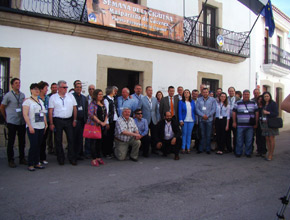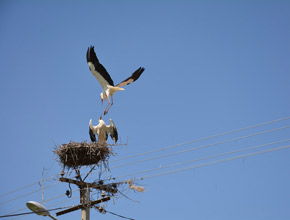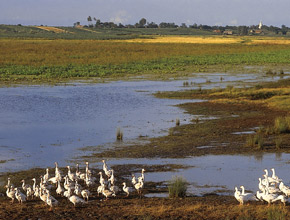News
Stork village meeting in Slovakia: A look at challenges and successes in stork conservation
The annual meeting of European stork villages took place for the first time in the Slovakian stork village of Buzica from 25 to 28 May. Around 30 participants from seven villages discussed the latest developments, challenges and successes in European stork conservation. More
English stork village honoured: Storks back on the island
It has taken nearly ten years for the network to grow again, but now the European Stork Villages initiative has another new member: The Knepp Estate and the village of Storrington in England have been honoured by EuroNatur for their merits in the successful reintroduction of white storks to the UK. More
Knepp and Storrington named ‘European Stork Village’
Knepp Estate and the village of Storrington in West Sussex have jointly been designated ‘European Stork Village’ by the EuroNatur foundation, recognising their role in the successful introduction of white storks to the UK. More
Stork Village meeting in Tykocin, Poland
It was an anniversary celebrated in style: For the 20th annual meeting, representatives of the European Stork Villages met for the first time in the Polish Stork Commune of Tykocin/Pentowo. The hosts organised an event that not only ran smoothly but was also packed with atmosphere. More
Stork village meeting in Taraš in Serbia
At long last a meeting face to face: After a pause of two years enforced by Covid, representatives from seven European Stork Villages met together in Taraš. More
19th European Stork Villages Network Meeting
The 19th ESVN meeting will take place in Taraš-Serbia, from 18th to 21st July 2022. After online meetings due to the pandemic, the organisers are looking forward to meeting again in person. More
Google Map
This map is currently hidden to protect your privacy. If you click the button below it will be loaded from Google.
When enabling the checkbox below your preference will be stored as a cookie to automatically display all maps on page load. The cookie will be stored for one week.
The European Stork Villages Network

With the “European Stork Villages” initiative EuroNatur has set up a movement to help counterbalance the habitat loss for storks in Europe. Since 1994 the EuroNatur foundation has honoured the contribution of 15 villages in 15 European countries for their engagement in white stork and nature conservation with the title “European Stork Village”. Candidates for the title are villages or parishes with resident stork colonies. The local people have put much time and energy into the protection of storks, for example by adopting extensive farming practices and of conserving large areas of wetland. With the title, the communities are internationally recognized as special cultural and natural heritage sites. In this way we are working to encourage successful approaches to the protection of nature in general and white storks in particular.
The White Stork

The White Stork is so popular one could call it an avian pop star. It is known as the bringer of babies, luck and fertility all over Europe. It has been used in advertising campaigns for beer, nappies, condoms and various other goods, it can be seen on stamps and adorning coins. But where can this charismatic and beautiful bird still be seen in the wild? And did its status as a pop star help the species after all?
In short: Yes, it did help, but it didn´t prevent the vanishing of storks from areas where wetlands, wet meadows and extensive agriculture have disappeared. Storks and wetlands belong together and thus the White Stork is the European ambassador for the protection and restauration of wetlands, wet meadows and pastures.
Wet meadows and pastures

In the Croatian Lonjsko Polje Nature Park home of the first European Stork Village, Čigoč, a lesson comes alive. A lesson on how people can utilize wet meadows and pastures and at the same time share the natural wealth of these habitats with a bounty of wild species. In spring the area teems with wildlife. Storks, herons and spoonbills feast on the abundance of frogs, snakes and insects. White-tailed eagles soar through the sky and in the evenings the air is filled with the croaking of the European tree frog and the characteristic moaning of the fire-bellied toad. For many generations people in Čigoč have been using the floodplains of the river Save to raise their cattle, horses and pigs and at the same time as a natural flood prevention system. The regular flooding provides nutrients and moisture to the meadows, pastures and woodlands. It nourishes the farm animals and a diverse fauna and flora. Nowadays local people benefit from their traditional pasturing system in yet another way: The beauty of the landscape and the biodiversity attract bird watchers and nature lovers from all over Europe and are thus supporting small ecotourism enterprises and the Nature Park Lonjsko Polje.
Partners
EuroNatur is a charitable foundation which is based in Radolfzell, Germany. In our project activities we focus like no other organisation on creating nature conservation across national borders. As an internationally active nature conservation foundation we have made it our task to conserve our European natural heritage in all its diversity and to protect precious natural and ecologically valuable traditionally cultivated landscapes in Europe.
Read moreCICONIA is a charitable foundation and was founded in 1997 in Schaan (Principality of Liechtenstein). The aim is to support nature conservation and environmental education projects along the international migration route of White and Black Storks. Comprehensive habitat improvements and protection are realized. In Addition, environmental education projects contribute to long-term sustainability in nature and environmental protection.
Read moreStorch Schweiz was created over 40 years ago to provide scientific governance and coordinate the reintroduction of White Storks in Switzerland. It uses the species as a flagship to promote and support habitat restoration measures and sustainable agricultural practices in densely populated landscapes. Storch Schweiz elaborated a national action plan, monitors the Swiss population and coordinates European-wide efforts along its migration routes.
Read more Report sighting
Report sighting
Have you seen a white stork or another interesting species of animal, plant or fungus? Make your observation count for nature conservation and share it with other nature lovers! It’s free and it’s fun!





